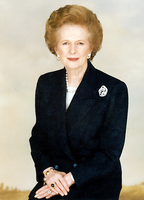First Thatcher ministry
| First Thatcher Ministry | |
|---|---|
| 85th ministry of United Kingdom (since 1707) | |
| 1979–1983 | |
 |
|
| Date formed | 4 May 1979 |
| Date dissolved | 9 June 1983 |
| People and organisations | |
| Head of government | Margaret Thatcher |
| Deputy head of government | William Whitelaw |
| Head of state | Queen Elizabeth II |
| Member party | Conservative Party |
| Status in legislature | Majority |
| Opposition cabinet |
Callaghan Shadow Cabinet Foot Shadow Cabinet |
| Opposition party | Labour Party |
| Opposition leader |
James Callaghan (1979–80) Michael Foot (1980–83) |
| History | |
| Election(s) | 1979 general election |
| Outgoing election | 1983 general election |
| Predecessor | Callaghan ministry |
| Successor | Second Thatcher ministry |
Margaret Thatcher was Prime Minister of the United Kingdom from 4 May 1979 to 28 November 1990, during which time she led a Conservative government. She was the first woman to hold that office. During her premiership, Thatcher moved to liberalise the British economy through deregulation, privatisation, and the promotion of entrepreneurialism. This article details the First Thatcher Ministry, which existed from 1979 until 1983.
Following the vote of no confidence against the Labour government and prime minister James Callaghan on 28 March 1979, a general election was called for 3 May 1979. The Winter of Discontent had seen the Labour government's popularity slump during the previous four months, and the opinion polls all pointed towards a Conservative victory.
The Tories won the election with a majority of 44 seats and their leader Margaret Thatcher became Britain's first female prime minister.
Thatcher inherited some of the worst economic statistics of postwar Britain. The nation was still feeling the effects of the numerous strikes during the recent Winter of Discontent. Inflation had recently topped 20%, and unemployment was in excess of 1.5 million for the first time since the 1930s.
Thatcher's monetarist and deflationary economic policies saw a cut in the inflation rate from a high of 22% in May 1980 to just over 13% by January 1981, and by June 1983 it had fallen to a 15-year low of 4.9%.
She also oversaw union reforms which saw strikes at their lowest for 30 years by 1983. However, her economic policies also resulted in the loss of much of Britain's heavy industry. Coal pits, steel plants, machine-tools and shipyards were particularly hard hit, most of all in Scotland, Northern Ireland and the north of England. By 1983, unemployment had reached 3.2 million, although economic growth was now re-established following the recession of 1980 and 1981.
...
Wikipedia
